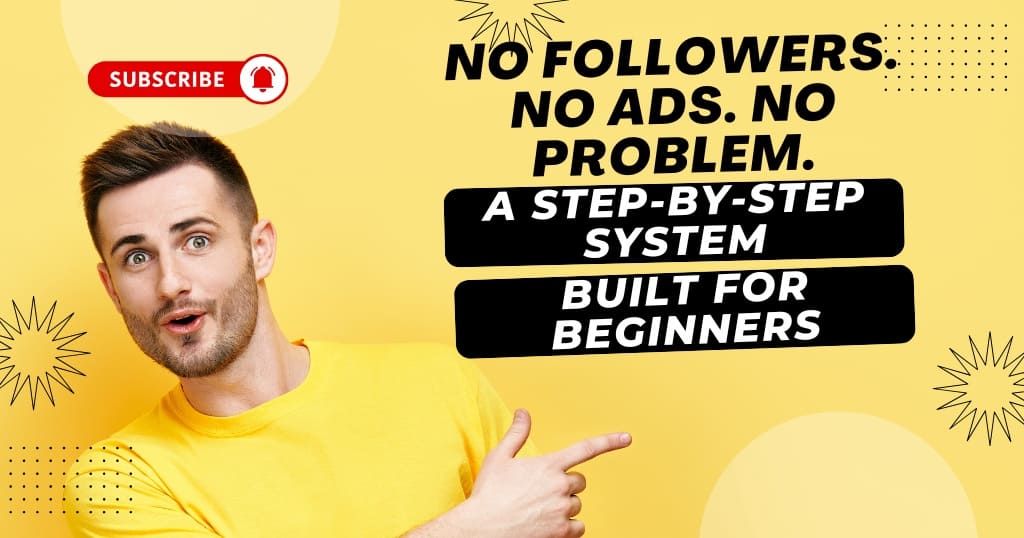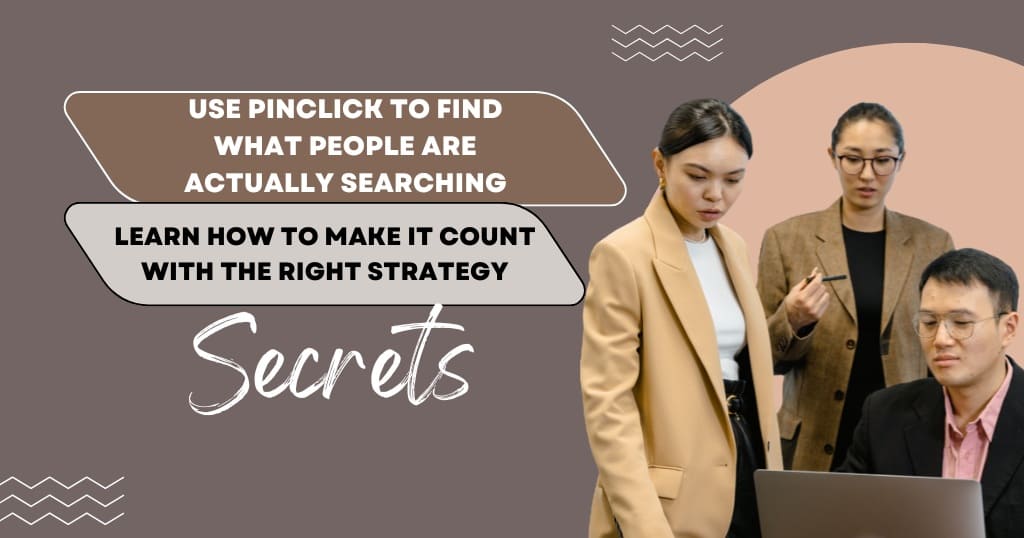🚨 The Day I Almost Gave Up on Pinterest Affiliate Marketing
I still remember sitting in my tiny home office in Pune, staring at my Pinterest account with zero clue what I was doing. I had just spent two weeks tweaking my blog and posting pins that got exactly… 2 clicks.

Frustrated, I asked myself the same thing you probably are right now:
“Can I actually make money with affiliate links on Pinterest — even without a blog or big following?”
What happened next changed everything.
I discovered a smarter way to use Pinterest — not as a place to “go viral,” but as a silent search engine where my affiliate pins could quietly work in the background, 24/7. Within 30 days, I started seeing daily clicks to my links — without ads, without followers, and without burning out on content.
In this guide, I’ll break down exactly how Pinterest affiliate marketing works, what tools helped me simplify the process (including my favorite: Pinclick), and how you can start earning passive income from your pins — even if you’re starting from scratch.
How do I start Pinterest affiliate marketing in 2025? To start Pinterest affiliate marketing, create a free Pinterest business account, join an affiliate program, use a keyword tool like Pinclick, design helpful pins in Canva, and post consistently using relevant search terms. You don’t need a blog or followers — just a smart strategy and a few well-optimized pins.
📌 What Is Pinterest Affiliate Marketing?
Pinterest affiliate marketing is a way to make money by posting pins that link to affiliate products or services. When someone clicks on your pin and buys something — you earn a commission.
Think of Pinterest like a search engine (not social media). People go there to look for ideas: outfits, gifts, tools, planners, skincare, home hacks… everything. Your job? Create pins that help them discover helpful products — and get paid when they buy.
💡 Here’s the best part:
You don’t need a blog, you don’t need followers, and you don’t need to show your face. Pinterest lets you add affiliate links directly to your pins, making it one of the simplest entry points for beginner marketers.
It’s like building tiny digital billboards. You design a pin once, post it, and let Pinterest show it to searchers month after month.
🌱 Why Pinterest Is Perfect for Beginners
When I first started affiliate marketing, I thought I needed a blog, an email list, or at least a YouTube channel. But none of those felt doable. What I didn’t realize is that Pinterest levels the playing field — especially for beginners.
Here’s why it works so well:
✅ You Don’t Need Followers to Get Views
Pinterest is a visual search engine, not a social platform. That means your pins can show up in front of searchers even if your account is brand new.
✅ You Can Post Direct Affiliate Links
Unlike Instagram or TikTok, Pinterest actually welcomes direct affiliate links (as long as they’re helpful and relevant). That’s a big deal.
✅ Your Content Works Forever (Not Just 24 Hours)
A good pin can bring traffic for months or even years — without you constantly posting or showing up online.
✅ Free Organic Traffic
You don’t need to run ads or have a big budget. Just consistent pinning + smart keywords = daily link clicks.
✅ Beginner-Friendly Tools
With free tools like Canva for pin design and Pinclick to track your links, getting started is easier than ever.
Pinterest gave me what other platforms didn’t: quiet growth, consistent clicks, and freedom from the “always online” grind. That’s why I believe it’s the best entry point for anyone starting out.
🔗 How Affiliate Links Work on Pinterest (Yes, It’s Allowed!)
I was skeptical too. Every time I searched “Pinterest affiliate marketing,” I saw old advice warning that Pinterest didn’t allow direct links.
Here’s the truth (as of 2025):
✅ Yes, Pinterest allows affiliate links — and has for years now.
You can legally and ethically add affiliate URLs to your pins — as long as you follow Pinterest’s spam rules and use clear disclosures.
🧩 Here’s how it works:
- You join an affiliate program (like Amazon, ClickBank, or Pinclick)
- You get a unique tracking link for the product
- You design a pin promoting the product (in Canva, etc.)
- You publish it on Pinterest and paste your affiliate link into the pin’s URL field
- When someone clicks and buys → you earn a commission
🔒 But what about safety?
To protect your account and get accurate stats, it’s smart to shorten or cloak your affiliate links. That’s why I personally use Pinclick — a Pinterest-approved tool that lets you:
- Shorten long affiliate links into clean, trackable ones
- Preview performance (clicks, conversions)
- Stay 100% compliant with Pinterest’s terms
And yes — I’ll show you exactly how to use Pinclick in the next section of this guide.
🛠️ Step-by-Step Strategy to Start Pinterest Affiliate Marketing
If I were starting from scratch today, here’s exactly what I’d do — no fluff, no fancy tools, just simple steps to get your first affiliate pin live and earning clicks.

✅ Step 1: Set Up a Pinterest Business Account
- Go to business.pinterest.com
- Create a free business account (or convert your personal one)
- Why it matters: You’ll unlock analytics, pin scheduling, and can verify your website later
✅ Step 2: Choose a Simple Niche
Pick something you’re interested in or already shop for. Popular affiliate-friendly niches:
- Amazon must-haves
- Home decor & storage
- Self-care routines
- Travel gear
- Digital products (like ebooks, printables, PLR)
💡 Tip: You can test multiple niches early — Pinterest doesn’t penalize variety.
✅ Step 3: Join 1–2 Affiliate Programs
Here are beginner-friendly ones that work great on Pinterest:
- Amazon Associates – Easy to get approved
- ClickBank – Digital products with high commissions
- Pinclick – Helps track and cloak Pinterest affiliate links (more on this below)
- CJ Affiliate / Impact / ShareASale – For name-brand physical products
✅ Step 4: Create a Product Pin in Canva
- Open Canva.com
- Use a free Pinterest Pin template (1000x1500px)
- Add a product image, bold headline (ex: “Must-Have Fall Planner”), and CTA text
- Save your design as a PNG
✅ Step 5: Add Your Affiliate Link
When uploading your pin to Pinterest:
- Title: Use clear keywords (ex: “Fall Planner for Busy Moms”)
- Description: Add value + keywords (ex: “This planner helped me organize my entire week in under 10 minutes. Perfect for moms and students.”)
- Destination link: Paste your shortened affiliate link (from Pinclick or your affiliate dashboard)
✅ Step 6: Be Consistent with Pinning
Pinterest rewards fresh pins — aim for 3–5 per week starting out.
Don’t worry about perfection. Just keep going.
Within my first month of doing just this — I started seeing daily clicks from pins I forgot I even posted. It’s not magic. It’s just quiet, compounding traffic.
🔍 My Favorite Tool: Pinclick (And Why I Recommend It)
One of the biggest mistakes I made when I started Pinterest affiliate marketing? Guessing what people were searching for.
I’d write random pin titles like “My Favorite Travel Essentials” or “Amazon Finds You’ll Love” — and they’d get zero traffic. Why? Because Pinterest is a search engine, and if you’re not using the right keywords, your pins won’t show up.
That’s when I found Pinclick — and it changed everything.
💡 What Is Pinclick?
Pinclick is a Pinterest keyword research tool that shows you:
- The exact keywords people are typing into Pinterest
- Related keyword ideas based on any niche
- How to structure your pin titles and descriptions for better visibility
🛠️ How I Use It in My Workflow:
- I type in a niche (like “fall outfits” or “self-care”)
- Pinclick gives me a list of real, trending keywords
- I use those keywords in my pin titles, descriptions, and boards
- My pins get shown to more people — which means more affiliate clicks
I call it my secret Pinterest SEO weapon — because before using Pinclick, I was just guessing. Now, I’m creating pins based on real demand. That’s when the traffic started to grow.
📣 Want to Try Pinclick?
If you’re ready to stop guessing and start growing your traffic the smart way, try Pinclick here → Pinclicks
It’s simple, affordable, and designed for affiliate marketers like us who want free Pinterest traffic — without spending hours on research.
⚠️ Common Mistakes Beginners Make (And How to Avoid Them)
When I look back at my first 30 pins, I cringe a little. 😅
I made every mistake in the book — but they taught me exactly what not to do. If you’re just starting Pinterest affiliate marketing, please learn from these so you don’t waste time like I did.

❌ Mistake #1: Using Vague Titles Like “Amazon Must-Haves”
Pinterest is a search engine, not Instagram. People aren’t looking for cute captions — they’re typing specific keywords.
✅ Instead: Use tools like Pinclick to find real search terms like “Fall Amazon Fashion Under $50” or “Travel Essentials for Carry-On Only.”
❌ Mistake #2: Posting Just One Pin and Hoping It Goes Viral
I thought I could post a few pretty pins and wait for traffic. Nope.
✅ Instead: Be consistent. Aim for 3–5 fresh pins per week to start seeing traction.
❌ Mistake #3: Linking to Bad Product Pages
One of my pins linked to a product with a poor Amazon rating — and I wondered why nobody bought.
✅ Instead: Promote products with 4+ star reviews, great photos, and helpful descriptions.
❌ Mistake #4: Not Disclosing Affiliate Links
Pinterest wants transparency — and so do users.
✅ Instead: Add a short line in your description like “This pin contains affiliate links, which means I may earn a small commission at no extra cost to you.”
❌ Mistake #5: Ignoring Pinterest SEO Basics
I didn’t even know what “alt text” or “board descriptions” were.
✅ Instead: Optimize everything — pin titles, descriptions, board names, and profile bio. Pinterest reads all of it.
Bottom line? You don’t need to be perfect — just intentional. Every mistake above slowed me down. Once I corrected them, things started clicking.
🎯 How to Get More Clicks (Pinterest SEO + CTA Hacks)
Getting your pins seen is one thing.
Getting people to click them? That’s where strategy kicks in.
After testing 100+ pins, I learned that two things drive results:
✅ Pinterest SEO (so your pin gets discovered)
✅ Strong CTAs (so people actually click)
📌 Pinterest SEO Basics You Can’t Skip:
1. Use Real Keywords in Your Pin Titles
Instead of “Cozy Vibes 🍂” → Use: “Fall Amazon Outfits for Women Under $50”
Use Pinclick to find these keyword phrases.
2. Optimize Pin Descriptions Naturally
Write like a helpful tip, not a robot.
✅ Ex: “This $30 moisturizer saved my dry skin during winter. Lightweight, non-greasy, and under $35 — found it on Amazon!”
3. Use Keyword-Rich Board Names
Don’t use “My Favorites” — use “Fall Amazon Fashion Finds” or “Self-Care Must-Haves”
4. Add Alt Text to Pins
Pinterest uses this to understand your image. Write what the pin shows + keywords.
💡 Call-to-Action (CTA) Hacks That Actually Work:
✔ Use Clickable Text on Your Pin Image
- “Shop Now on Amazon”
- “Find It Here”
- “Must-Have Gift Under $25”
- “Get This Printable Freebie”
✔ Include a Soft CTA in Your Description
- “You can find it here 👉 [affiliate link]”
- “Linked in pin!”
- “This changed my routine — grab it below!”
✔ Create Curiosity
Ex: “This $7 tool boosted my Pinterest reach by 10x — it’s linked in the pin!”
Remember: Pinterest users aren’t just scrolling — they’re searching with intent. If your pin solves their problem and tells them what to do next, you win.
📊 How to Track Affiliate Clicks & Performance
One of the best feelings? Waking up, checking your stats, and seeing that your pin got clicks while you slept.
But how do you know which pins are actually working — and which ones are just… pretty but pointless?

🧩 Here’s How I Track My Pinterest Affiliate Performance:
✅ 1. Use Your Affiliate Dashboard
Most programs (like Amazon, ClickBank, or ShareASale) show:
- Number of clicks
- Which links were clicked
- If a sale happened
- Commission earned
💡 Pro Tip: Create a separate affiliate link for each pin so you know exactly what’s performing.
✅ 2. Use Pinclick for Keyword Tracking
While Pinclick doesn’t track affiliate clicks, it helps me spot keyword trends.
If I notice pins with “fall outfits under $50” are doing better, I double down on that theme.
✅ 3. Monitor Pinterest Analytics (Business Account Required)
Go to your Pinterest Analytics dashboard →
Click “Pins” → “Outbound Clicks”
This shows you:
- Which pin is getting the most clicks to your links
- How different boards are performing
- What content drives the most engagement
✅ 4. Track in a Simple Google Sheet
I use a basic sheet to log:
- Pin title
- Date posted
- Link used
- Niche/topic
- Clicks (from affiliate dashboard or Pinterest)
- Sales
This helps me repeat what works and ditch what doesn’t.
Don’t overthink tracking in the beginning — but do start measuring. You’ll be surprised how one well-written, well-targeted pin can outperform 10 random ones.
🧠 Final Thoughts: My Advice After 1 Month of Testing
If you’re still reading this, you’re probably just like I was: curious, cautious, and a little overwhelmed.
I get it. I wasn’t some pro with fancy tools. I didn’t have a blog, a big email list, or even 100 followers.
But what I did have was consistency. And the courage to test just one strategy until it clicked.
After 30 days of pinning, researching with Pinclick, and sticking to a simple posting rhythm, I started seeing real results:
- Outbound clicks daily (without ads)
- Pins that ranked in search weeks after posting
- Affiliate dashboards finally showing commissions
That was the moment I knew: this works — even for beginners.
So if you’ve been stuck in research mode, waiting for the “perfect” moment to start…
Let this be your sign: Start messy. Start now. Just start.
The traffic you want is already on Pinterest. You just need to put the right pins in front of them.
🚀 Ready to Start Smarter? Use Pinclick to Find Your First Winning Pin
If I could go back and change one thing about how I started, it would be this:
I would have stopped guessing and started using real Pinterest keywords from day one.
That’s why I recommend Pinclick — the exact tool I use to plan every single pin I post. It’s fast, beginner-friendly, and shows you what Pinterest users are actually searching for right now.
🔍 With Pinclick, you can:
- Discover high-traffic keywords in your niche
- Create better pin titles and descriptions
- Increase your chances of showing up in search
- Avoid wasting time on low-interest topics
Want to try it out?
Click below to check it out — and yes, this is my affiliate link (which means I may earn a small commission if you sign up, at no extra cost to you):
👉 Try Pinclick Now & Start Smarter
📝 Affiliate Disclosure– This article contains affiliate links, which means I may earn a small commission if you click through and make a purchase — at no extra cost to you. I only recommend tools I’ve personally used and truly believe will help you grow.
FAQ
Can you do affiliate marketing on Pinterest without a blog?
Yes! Pinterest allows you to post direct affiliate links on your pins. You don’t need a blog or website to get started. All you need is a Pinterest business account, an affiliate program, and high-quality pins that use the right keywords.
Do I need followers to make money with Pinterest affiliate marketing?
No, Pinterest is a search engine, not a social platform. Your pins can show up in search results even if you have zero followers — as long as you optimize them using Pinterest SEO and tools like Pinclick.
What affiliate programs work well with Pinterest?
Some beginner-friendly affiliate programs include:
Amazon Associates
ClickBank
ShareASale
CJ Affiliate
Digital product networks (like PLR stores)
Choose a program that fits your niche and allows direct linking.
Is Pinterest affiliate marketing allowed in 2025?
Yes! Pinterest officially allows affiliate links as long as you’re not spamming or misleading users. Just be sure to add a short disclosure in your pin descriptions.
How do I find the best keywords for Pinterest pins?
Use a Pinterest-specific keyword tool like Pinclick. It helps you find high-volume, trending keywords that people are actually searching for — so your pins get seen.
How long does it take to see results with Pinterest affiliate marketing?
If you post consistently (3–5 pins/week), use SEO correctly, and promote good products, you may start seeing clicks within 2–4 weeks. Pinterest is a slow burn, but traffic can build up over time and run passively.
